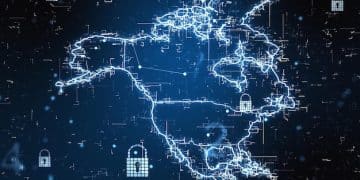US cyberattack readiness: Critical infrastructure targeted?

The preparedness of US critical infrastructure against escalating cyberattacks remains a complex, evolving challenge, balancing advanced defense strategies with persistent vulnerabilities across diverse sectors.
In an increasingly digital world, the threat of cyberattacks looms large, particularly when it comes to vital systems. The pressing question being asked today is, Is the US Prepared for the Predicted Increase in Cyberattacks Targeting Critical Infrastructure? This inquiry delves into the resilience of the nation’s essential services, from energy grids to financial networks, against the backdrop of an evolving and aggressive cyber threat landscape.
understanding the threat landscape
The digital age, while ushering in unprecedented connectivity and efficiency, has also opened new vectors for malicious actors. Cyber adversaries, ranging from state-sponsored groups to cybercriminals and hacktivists, are constantly refining their tactics. Their primary targets often include critical infrastructure due to the immense disruptive potential and strategic leverage it offers.
Understanding this complex and dynamic threat landscape is the first step in assessing a nation’s preparedness. It’s not merely about the number of attacks, but their sophistication, persistence, and the intent behind them. These threats exploit both known and zero-day vulnerabilities, creating a continuous arms race between defenders and attackers.
evolving adversary capabilities
Adversary capabilities are not static; they evolve rapidly, driven by technological advancements and geopolitical shifts. State-sponsored groups, for instance, often possess significant resources and expertise, enabling them to launch highly sophisticated and stealthy attacks aimed at espionage, sabotage, or intellectual property theft. Their methods often involve advanced persistent threats (APTs) that can remain undetected within networks for extended periods.
- 📈 Sophisticated malware and ransomware variants.
- 🔗 Supply chain exploitations and third-party compromises.
- 🧠 Artificial intelligence and machine learning for enhanced attacks.
- 🕵️♂️ Advanced persistence techniques to evade detection.
geopolitical influences on cyber warfare
Cyber warfare is inextricably linked to geopolitical tensions. Nations engage in cyber activities to gain strategic advantages, influence elections, disrupt economies, or project power without resorting to conventional military force. This means that an escalation in geopolitical conflicts often translates into an increase in cyber offensive operations, directly impacting critical infrastructure. The interconnectedness of global networks also means that an attack originating in one part of the world can have ripple effects globally, making cyber defense a truly international concern.
The constant interplay between nation-states, non-state actors, and the private sector demands a holistic understanding of the motivations and capabilities driving these cyber threats. Without this deep insight, defensive strategies risk being reactive rather than proactive, leaving critical infrastructure vulnerable to predictable, yet potentially devastating, assaults.
current state of us critical infrastructure cybersecurity
The United States has long recognized the imperative of securing its critical infrastructure, making significant investments in cybersecurity frameworks, initiatives, and partnerships. However, the sheer breadth and complexity of these systems—spanning sectors like energy, transportation, finance, and healthcare—present an immense challenge. Assessing the current state of cybersecurity within these domains requires a nuanced look at existing defenses, remaining vulnerabilities, and the pace of adaptation to new threats.
While certain sectors, particularly those with higher security classifications or private sector involvement, have advanced considerably, uniformity in preparedness remains a hurdle. Legacy systems, resource constraints, and varying levels of cybersecurity maturity across different entities mean that the national defense posture is far from monolithic.
federal initiatives and frameworks
The US government has established several key initiatives and frameworks to bolster critical infrastructure cybersecurity. Agencies like the Cybersecurity and Infrastructure Security Agency (CISA) play a pivotal role in disseminating threat intelligence, providing guidance, and fostering collaboration. The NIST Cybersecurity Framework, a voluntary set of guidelines, offers a systematic approach to managing cyber risks and has been widely adopted across industries. These frameworks promote a standardized, risk-based approach to cybersecurity, emphasizing identification, protection, detection, response, and recovery.
- 📚 National Institute of Standards and Technology (NIST) Cybersecurity Framework.
- 🛡️ CISA’s National Critical Functions (NCF) framework.
- 🤝 Information Sharing and Analysis Centers (ISACs) for sector-specific collaboration.
- 🧪 Continuous monitoring and vulnerability assessment programs.

sector-specific vulnerabilities and strengths
Each critical infrastructure sector possesses unique characteristics that influence its cybersecurity posture. For instance, the energy sector, with its operational technology (OT) and industrial control systems (ICS), faces distinct challenges compared to the finance sector, which focuses more on data integrity and transaction security. Strengths often lie in dedicated security teams, advanced threat intelligence subscriptions, and participation in sector-specific information-sharing groups. However, vulnerabilities persist due to:
Outdated legacy systems that are difficult to patch or upgrade, a shortage of skilled cybersecurity professionals, and the increasing convergence of IT and OT networks, which expands the attack surface. Supply chain dependencies also introduce significant risks, as a compromise in one vendor can ripple through multiple critical systems. The reliance on digital technologies, while beneficial, also means that a single point of failure or a coordinated attack could have cascading effects, underscoring the need for robust, layered defenses tailored to each sector’s specific operational environment and threat profile.
challenges and gaps in preparedness
Despite significant efforts, the path to comprehensive cybersecurity readiness for US critical infrastructure is fraught with challenges and persistent gaps. These aren’t merely technical deficiencies but also involve human, organizational, and regulatory hurdles that impede a truly resilient defense posture. Addressing these multifaceted issues requires sustained commitment, innovative solutions, and a unified national strategy.
The dynamic nature of cyber threats means that even well-defended systems can become vulnerable as new attack methods emerge. This constant evolution demands continuous adaptation, which can be difficult for large, complex organizations, let alone entire sectors.
human element and skills gap
One of the most pressing challenges is the human element. Cybersecurity is not solely a technical problem; it often hinges on human behavior. Insider threats, both malicious and unintentional, remain a significant vulnerability. Furthermore, a severe shortage of skilled cybersecurity professionals plagues both the public and private sectors. This “skills gap” means that many organizations lack the personnel needed to design, implement, and manage robust security programs, conduct effective incident response, or stay ahead of evolving threats.
- 👨🎓 Shortage of trained cybersecurity professionals.
- 🚫 Human error and susceptibility to social engineering.
- 📉 Lack of continuous training and awareness programs.
- 🗣️ Communication breakdowns between IT, OT, and leadership.
interdependencies and cascading effects
Critical infrastructure sectors are not isolated entities; they are highly interdependent. For example, the energy sector relies on communication networks, which in turn depend on the physical infrastructure that electricity powers. A cyberattack on one sector can therefore trigger cascading failures across multiple others, amplifying the overall impact. This interconnectedness makes defense incredibly complex, as a successful attack on a seemingly minor component could have widespread, debilitating effects. Understanding and mapping these interdependencies is crucial for effective risk management and incident response, yet it remains a significant analytical challenge.
regulatory inconsistencies and compliance burdens
While various regulations exist to mandate cybersecurity practices in specific sectors (e.g., NERC CIP for the energy sector, HIPAA for healthcare), inconsistencies and sometimes overwhelming compliance burdens can hinder effective security. Different agencies may have overlapping or conflicting requirements, leading to “check-box” compliance rather than true security improvements. For smaller entities within critical infrastructure, the cost and complexity of compliance can be prohibitive, leaving them more vulnerable. Harmonizing regulatory efforts and shifting focus from mere compliance to proactive risk management are vital for improving overall resilience.
These challenges are compounded by the rapid pace of technological change and the persistent financial constraints faced by many infrastructure operators. Balancing cost, operational efficiency, and cybersecurity often requires difficult trade-offs, making comprehensive preparedness an ongoing uphill battle.
strategies for enhanced preparedness
Overcoming the challenges in cybersecurity preparedness requires a multi-pronged approach that integrates advanced technologies, robust policy, and continuous human development. The emphasis must shift from simply reacting to threats to proactively building resilience and fostering a culture of cybersecurity across all critical infrastructure sectors. This involves strategic investments, collaborative efforts, and a commitment to perpetual improvement.
Developing and implementing effective strategies is not a one-time effort but an ongoing process that adapts to the evolving threat landscape and leverages new opportunities for defense. The goal is to create a dynamic and adaptive defense ecosystem that can withstand sophisticated attacks.
strengthening public-private partnerships
Collaboration between government agencies and private sector critical infrastructure owners and operators is paramount. The vast majority of critical infrastructure is privately owned, meaning that effective national cybersecurity hinges on shared responsibility and information exchange. Strengthening existing public-private partnerships, such as ISACs, and establishing new avenues for intelligence sharing, joint exercises, and collaborative research and development can significantly enhance collective defense capabilities. Regularized threat briefings, combined with secure platforms for sharing indicators of compromise, ensure that all stakeholders are equipped with timely information to defend their systems.
- 🤝 Enhanced information sharing through ISACs and government advisories.
- 🔗 Joint cybersecurity exercises and drills.
- 💼 Collaborative red teaming and vulnerability assessments.
- 📊 Shared best practices and incident response playbooks.
investing in advanced technologies and AI
Technological advancements, particularly in artificial intelligence (AI) and machine learning (ML), offer powerful tools for enhancing cybersecurity. AI can be leveraged for automated threat detection, anomaly identification, and predictive analytics, helping to identify and mitigate attacks faster than human analysts alone. Investing in these sophisticated defensive technologies, along with quantum-resistant cryptography and zero-trust architectures, is crucial. Moreover, exploring the proactive use of AI for defensive “hunt” operations can provide an advantage in detecting sophisticated threats that bypass traditional security measures. These technologies can significantly reduce response times and bolster preventive measures.

workforce development and training
Addressing the cybersecurity skills gap requires a comprehensive national strategy for workforce development. This includes investing in educational programs from K-12 through higher education, promoting vocational training, and establishing accredited certification pathways. Continuous training and upskilling for existing professionals, especially those in operational technology (OT) environments, are equally important. Cultivating a diverse talent pool and encouraging interagency and inter-sectoral talent exchange can further strengthen the human element of defense. Moreover, fostering a culture of cybersecurity awareness from the top down, through regular training and simulation exercises, can mitigate human error and improve overall resilience.
These strategies, when implemented cohesively and with long-term vision, can significantly elevate the US’s preparedness level, creating more resilient critical infrastructure capable of withstanding the predicted increase in cyberattacks. It is a continuous journey that demands adaptability and persistent effort from all involved stakeholders.
the role of legislation and policy
Legislation and policy are foundational pillars for robust cybersecurity preparedness, providing the framework within which defensive strategies are conceived, funded, and enforced. Federal and state governments play a crucial role in shaping the regulatory environment, incentivizing best practices, and ensuring accountability across critical infrastructure sectors. However, striking the right balance between necessary oversight and fostering innovation, without imposing undue burdens, is a delicate act.
Effective policy must be dynamic, adapting to the rapid pace of technological change and the evolving nature of cyber threats. Stagnant regulations risk becoming obsolete, leaving critical systems vulnerable.
federal cybersecurity laws and mandates
The US has enacted a patchwork of federal laws and mandates aimed at improving cybersecurity. These range from sector-specific regulations, such as the North American Electric Reliability Corporation Critical Infrastructure Protection (NERC CIP) standards for the power grid, to broader federal requirements like the Federal Information Security Modernization Act (FISMA) for government agencies. Ongoing legislative efforts, like the Cyber Incident Reporting for Critical Infrastructure Act of 2022 (CIRCIA), aim to standardize incident reporting, providing a clearer picture of the threat landscape and facilitating coordinated response.
- 🏛️ Cyber Incident Reporting for Critical Infrastructure and Companies Act (CIRCIA).
- 🛡️ FISMA and other federal agency cybersecurity mandates.
- ⚡ NERC CIP standards for the energy sector.
- 💰 Proposed cyber insurance incentives and risk-sharing models.
incentivizing compliance and innovation
Beyond mandates, policy can also incentivize better cybersecurity practices. This includes tax credits for cybersecurity investments, funding for research and development into defensive technologies, and liability protections for companies that share threat intelligence. The goal is to encourage proactive security measures by making it economically viable and legally prudent for organizations to invest in their cyber defenses. Developing clear pathways for sharing sensitive threat information without fear of legal repercussions is vital for fostering greater collaboration and a collective defense posture among often competitive entities.
future policy directions and debates
The future of cybersecurity policy in the US will likely involve ongoing debates on several key fronts. These include the extent of government intervention versus industry self-regulation, the balance between security and privacy, and how to effectively manage the risks associated with emerging technologies like quantum computing and advanced AI. Discussions will also revolve around the need for a national cyber incident response plan, clarity on offensive cyber capabilities, and international cooperation to combat state-sponsored threats. The challenge lies in crafting policies that are comprehensive, adaptable, and forward-looking, ensuring that the regulatory environment supports, rather than hinders, the nation’s efforts to secure its critical infrastructure against an ever-evolving array of cyber threats.
Ultimately, effective legislation and policy are not just about compliance; they are about creating a resilient and secure digital ecosystem capable of protecting the essential services that underpin the nation’s stability and prosperity.
case studies and lessons learned
Examining past cyberattacks on critical infrastructure, both domestically and internationally, provides invaluable insights and highlights critical lessons that inform current and future preparedness strategies. These real-world incidents expose vulnerabilities, test response mechanisms, and underscore the complex challenges inherent in defending highly interconnected and often antiquated systems. Learning from these events is crucial for shoring up defenses and fostering resilience.
Every successful attack, and even every detected attempt, offers an opportunity to refine existing security protocols, improve incident response capabilities, and enhance threat intelligence. This iterative learning process is fundamental to staying ahead of sophisticated adversaries.
notable cyber incidents and their impact
The history of cyberattacks on critical infrastructure is replete with significant incidents that have had widespread impact. From the Stuxnet worm’s targeting of Iranian nuclear facilities to the Colonial Pipeline ransomware attack in the US, these events demonstrate the potential for cyber warfare to disrupt essential services, cause economic damage, and even threaten public safety. The impact of these attacks has ranged from localized outages and financial losses to significant geopolitical ramifications. Analyzing how these attacks penetrated defenses, what their primary objectives were, and the methods used for recovery provides a bedrock of knowledge for future preparedness.
- 🔌 Colonial Pipeline ransomware attack (2021) and fuel supply disruption.
- ⚡ Ukraine power grid attacks (2015, 2016) demonstrating OT/ICS vulnerabilities.
- 🌪️ Stuxnet (2010), a landmark attack on industrial control systems.
- 🧪 SolarWinds supply chain attack (2020), impacting government and private entities.
uncovering vulnerabilities and enhancing resilience
Each major cyber incident serves as a stark reminder of specific vulnerabilities—whether technical, human, or procedural. The Colonial Pipeline attack, for instance, highlighted the dangers of outdated IT systems and inadequate segmentation between operational and IT networks. The Ukrainian power grid incidents exposed weaknesses in industrial control systems and the need for robust real-time anomaly detection. These lessons compel organizations to:
Conduct thorough vulnerability assessments, implement multi-factor authentication, enhance network segmentation, and prioritize patch management. They also underscore the importance of robust incident response plans, including communication protocols, data backup and recovery strategies, and the ability to operate in a degraded or manual mode. A key takeaway is the need for proactive “purple teaming”—where offensive (red team) and defensive (blue team) security professionals collaborate to identify and fix vulnerabilities before they can be exploited by actual adversaries. Learning from these real-world events provides a pragmatic approach to enhancing resilience.
Furthermore, these case studies emphasize that resilience is not just about preventing attacks but also about the ability to quickly detect, contain, and recover from them, minimizing disruption and restoring services efficiently. This involves not only technological measures but also training personnel to recognize threats and respond effectively under pressure, ensuring that human factors are as resilient as the technological defenses.
forward look: preparing for future threats
The landscape of cyber threats is in constant flux, driven by technological advancements, geopolitical shifts, and the ingenuity of adversaries. Therefore, US preparedness for critical infrastructure cyberattacks must be future-proofed, anticipating emerging threats and continuously adapting defensive strategies. This forward-looking perspective goes beyond current vulnerabilities, focusing on building long-term resilience and fostering an agile response capability for the unknown challenges of tomorrow.
Preparing for future threats demands not just reactive improvements but a proactive, innovative mindset, investing in foresight and developing capabilities that can address threats not yet fully materialized.
emerging technologies and associated risks
The rapid evolution of technologies presents both opportunities for enhanced defense and new vectors for attack. The proliferation of the Internet of Things (IoT) will significantly expand the attack surface, potentially introducing millions of vulnerable endpoints into critical networks. Quantum computing, while still nascent, poses a long-term threat to current encryption standards. Furthermore, the increasing reliance on artificial intelligence (AI) and machine learning (ML) in critical systems offers efficiency but also new types of vulnerabilities if these systems are compromised or manipulated. Preparing for these involves:
- 🌐 Securing IoT devices and their integration into existing networks.
- 🔒 Developing and transitioning to quantum-resistant cryptography.
- 🤖 Addressing AI/ML vulnerabilities like data poisoning and adversarial attacks.
- ⚡ Managing risks associated with highly distributed energy grids and autonomous systems.
proactive defense and threat intelligence
A truly prepared nation moves beyond merely reacting to attacks and embraces proactive defense. This involves continuous threat hunting, not just waiting for alerts but actively seeking out signs of compromise within networks. Advanced threat intelligence, including deep dives into adversary tactics, techniques, and procedures (TTPs), is crucial for anticipating attacks. Predictive analytics, driven by large datasets and machine learning, can help identify potential targets or methods before they are widely adopted by adversaries. Establishing resilient, geographically dispersed critical infrastructure systems and robust fallback mechanisms can ensure continuity of operations even under severe cyber duress.
international cooperation and norms
Cyber threats often transcend national borders, making international cooperation indispensable. Establishing global norms for responsible state behavior in cyberspace, fostering joint cyber defense exercises with allies, and sharing threat intelligence with international partners are critical. Diplomatic efforts to deter state-sponsored attacks and hold malicious actors accountable are also vital. A united front, built on shared understanding and mutual defense agreements, significantly strengthens collective resilience against sophisticated, cross-border cyber campaigns. Continuing to build these international relationships and legal frameworks will remain a cornerstone of future preparedness.
By continuously investing in these areas, the US can aim to build a truly resilient critical infrastructure capable of adapting to future cyber challenges, ensuring national security and economic stability in an increasingly digital and interconnected world. This ongoing effort is essential for safeguarding the nation’s vital services and maintaining its strategic edge.
| Key Aspect | Summary |
|---|---|
| 📊 Threat Landscape | Evolving, sophisticated threats from state-sponsored actors and cybercriminals target critical infrastructure. |
| 🛡️ Current Defenses | Robust federal frameworks and sector-specific initiatives are in place, but preparedness varies. |
| 🚧 Challenges | Human error, skills gap, interdependencies, and regulatory inconsistencies pose significant hurdles. |
| 💡 Path Forward | Enhanced public-private partnerships, tech investments, workforce development, and adaptable policy are key. |
Frequently asked questions
▼
Critical infrastructure in the US includes systems and assets so vital that their incapacitation or destruction would have a debilitating impact on security, national economic security, national public health or safety, or any combination thereof. Examples include the energy grid, water systems, communications, financial services, transportation, and healthcare facilities, among others.
▼
AI significantly enhances cybersecurity by enabling automated threat detection, anomaly identification, and predictive analytics at speeds impossible for humans. It can rapidly process vast amounts of data to spot patterns indicative of attacks, improve incident response times, and assist in identifying vulnerabilities before they are exploited. AI also supports threat intelligence by analyzing adversary tactics.
▼
Key challenges include legacy systems with outdated security, a persistent shortage of skilled cybersecurity professionals, cascading interdependencies between sectors, and the rapid evolution of sophisticated cyber threats. Regulatory inconsistencies and the difficulty of balancing security with operational efficiency also present significant hurdles for robust defense.
▼
Public-private partnerships are immensely important, as most critical infrastructure is privately owned. Collaboration facilitates crucial information sharing, joint exercises, and synchronized responses to evolving threats. These partnerships ensure that both government intelligence and private sector operational insights are leveraged collectively to build a more comprehensive and resilient national cybersecurity posture.
▼
International norms help establish agreed-upon rules of behavior in cyberspace, reducing the likelihood of disruptive cyberattacks and fostering stability. They provide a framework for diplomatic engagement, allow for coordinated responses to malicious activities, and encourage global cooperation in threat intelligence sharing, ultimately strengthening collective cyber defense against state-sponsored and transnational threats.
conclusion
The question of whether the US is prepared for an increase in cyberattacks targeting critical infrastructure is not a simple yes or no. The nation has made significant strides, implementing robust frameworks, fostering public-private partnerships, and investing in advanced technologies. However, persistent challenges such as the cybersecurity skills gap, legacy systems, and the complex interdependencies among sectors continue to highlight areas for improvement. The fluidity of the cyber threat landscape necessitates a continuous, adaptive, and collaborative approach. Ultimately, preparedness is an ongoing journey, demanding unwavering commitment to innovation, resilience building, and international cooperation to safeguard the essential services that underpin national security and prosperity.





